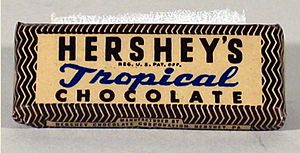Military chocolate (United States) facts for kids

D ration bar
|
|
| Type | Chocolate |
|---|---|
| Place of origin | United States |
| Created by | The Hershey Company |
| Main ingredients | Chocolate, sugar, oat flour, cacao fat, skim milk powder, artificial flavoring |
Military chocolate is a special kind of chocolate made for soldiers. It has been a part of U.S. military rations since 1937. This chocolate helps soldiers in two main ways. First, it gives them a lot of energy when they need it most. Second, it can cheer them up, acting as a small treat.
Military chocolate is often made differently from regular chocolate bars. It has to meet special rules for its weight, size, and how well it lasts. Most of this special chocolate comes from the Hershey Company. Sometimes, military chocolate is just like a regular bar, but packaged differently. Other times, it's made to be very tough and not melt easily.
Contents
The First Military Chocolate: D Ration Bar
The very first chocolate bar made for the U.S. Army was called the "D ration" bar. In 1937, an Army officer named Colonel Paul Logan asked Hershey's Chocolate to create it. He met with the company's president and chief chemist. Milton Hershey, the founder, was very interested in the idea.
Colonel Logan had four important rules for this new D ration bar:
- It had to weigh 4 ounces (about 113 grams).
- It needed to have a lot of food energy.
- It had to be able to handle very hot temperatures without melting.
- It should taste "a little better than a boiled potato." This was so soldiers wouldn't eat it unless it was a real emergency!
The D ration bar was made with chocolate, sugar, oat flour, and other ingredients. It even had vitamin B1 to keep soldiers healthy. Making this bar was hard because the special heat-resistant mix was very thick. Workers had to knead and press each bar by hand.
The finished D ration bar was a very hard, dark brown block. It was tough to eat and could handle temperatures up to 120°F (49°C). Each bar was wrapped in aluminum foil and put in a cardboard box. Three bars were supposed to give a soldier enough energy for a whole day.
The Army liked the first samples. They ordered 90,000 "Logan Bars" for testing. These bars were sent to soldiers in places like the Philippines and Panama. Some even went with Admiral Byrd on his trip to Antarctica. The tests went well, and the Army kept ordering them.
During World War II, the D ration bars were made to be poison gas-proof. Their boxes were covered with a special coating. Many of these bars were sent to soldiers all over the world. However, soldiers often disliked the D ration bar because of its bitter taste. Some even called it "Hitler's Secret Weapon" because it could upset their stomachs. It was so hard that soldiers often had to cut off small pieces with a knife to eat it.
The Tropical Bar: A New Try
In 1943, the Army asked Hershey's to make a better-tasting chocolate bar. This new bar still needed to survive extreme heat, especially for soldiers fighting in the Pacific. Hershey's created the "Tropical Bar." It came in 1-ounce and 2-ounce sizes at first.
The Tropical Bar looked and tasted more like a regular chocolate bar than the D ration. But even with improvements, many soldiers still found it hard to chew and not very tasty. They often traded it away for other food or goods. However, in some areas, like Burma, soldiers with dysentery found it was the only food they could keep down. They called it the "dysentery ration."
In 1957, the Tropical Bar's recipe was changed again. They removed the unpopular oat flour and added artificial vanilla flavoring. This made the bar taste much better, but it was still quite hard to chew.
Hershey's Big Role in the War
Between 1940 and 1945, Hershey's made billions of D ration and Tropical Bars for soldiers. In 1939, the Hershey plant could make 100,000 bars a day. By the end of World War II, the whole plant was making 24 million ration bars every week!
Because of their amazing work, the Hershey Chocolate Company received the Army-Navy ‘E’ Award for Excellence five times. This award recognized their high quality and huge production for the war effort.
Military Chocolate After the War
Production of the D ration bar stopped after World War II. But the Hershey's Tropical Bar continued to be a standard ration. It was used by soldiers in the Korean War and the Vietnam War. It was even taken into space on Apollo 15 in 1971!
"Desert Bar" (Congo Bar)
In the late 1980s, the U.S. Army tried to create another new high-temperature chocolate. Researchers called it the "Congo Bar." It could handle heat over 140°F (60°C) and had a fudge-like texture.
During Operation Desert Storm in the early 1990s, Hershey's sent many of these new "Desert Bars" to American troops. While some said it tasted good, soldiers had mixed feelings about it. The war ended before all the bars were shipped, so the rest were sold to the public in special "desert camo" wrappers. It was a fun novelty, but Hershey's didn't make more after they ran out.
See also
 In Spanish: Chocolate de las Fuerzas Armadas de Estados Unidos para niños
In Spanish: Chocolate de las Fuerzas Armadas de Estados Unidos para niños
Images for kids




